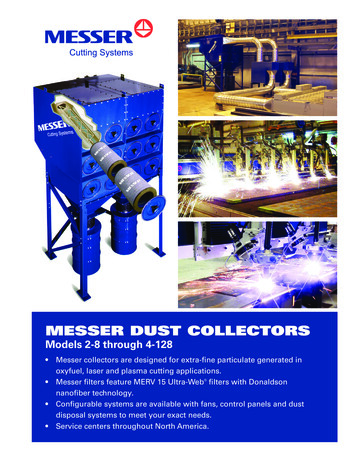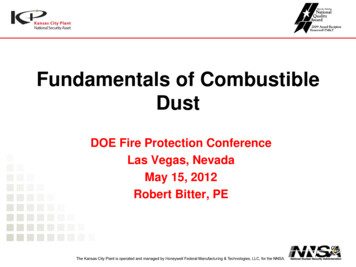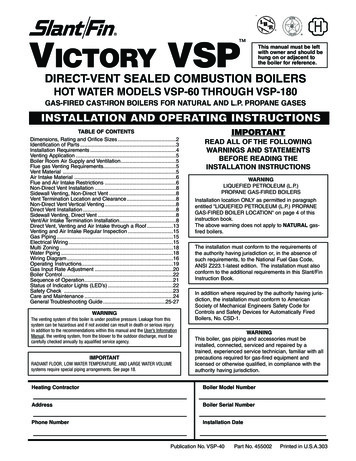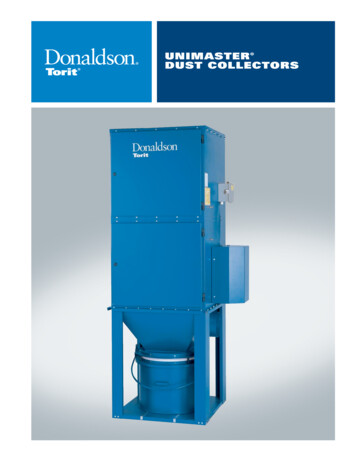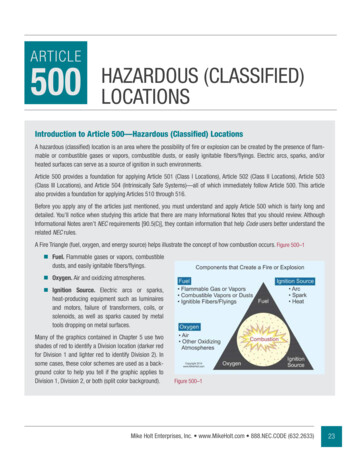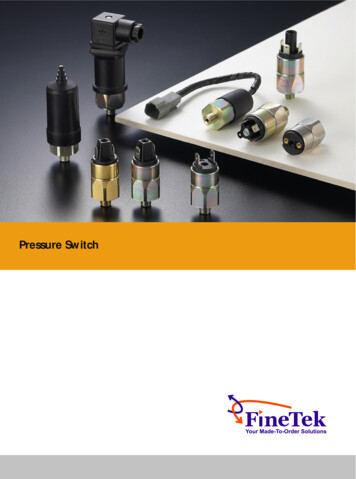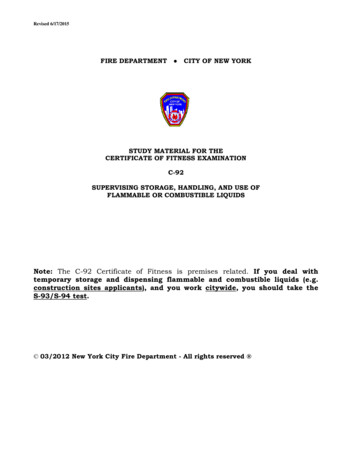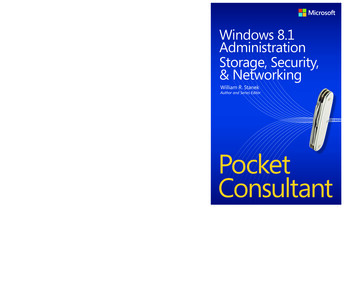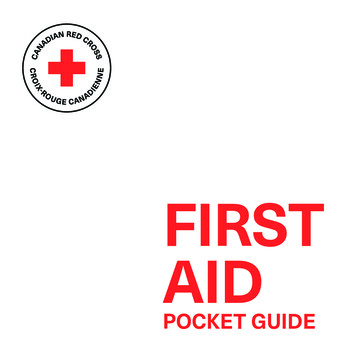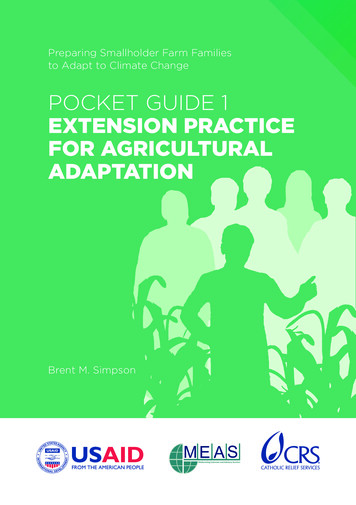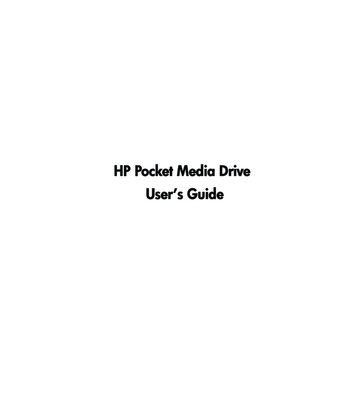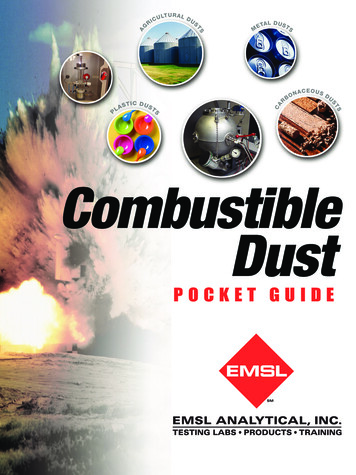
Transcription
W W W . E M S L . C O M 8 0 0 - 2 2 0 - 3 6 7 51
2C O M B U S T I B L ED U S TP O C K E TG U I D E
Table of ContentsCombustible DustWhat is Combustible Dust4How Dust Explosions Occur4Catastrophic Secondary Explosions5Industries at Risk5Where is Combustible Dust found?6-7Prevention of Dust Explosions8Dust Control Recommendations9Should You be Concerned9Sample Collection for Combustible Dust10Sample Submission to EMSL Analytical, Inc.11Common Combustible Dust TestsLaboratory Testing EquipmentW W W . E M S L . C O M 8 0 0 - 2 2 0 - 3 6 7 512 - 19203
What is Combustible DustCombustible dusts are fine particles that present an explosion hazardwhen suspended in air under certain conditions. A dust explosioncan cause catastrophic loss of life, injuries, and destruction of buildings. In many of these incidents, workers and managers were unaware of the potential for dust explosions, or failed to recognize theserious nature of dust explosion hazards. It is important to determineif your company has this hazard, and if you do, you must take actionnow to prevent tragic consequences.How Dust Explosions OccurIn addition to the familiar fire triangle of oxygen, heat, and fuel (thedust), dispersion of dust particles in sufficient quantity and concentration can cause rapid combustion known as a deflagration. If theevent is confined by an enclosure such as a building, room, vessel, orprocess equipment, the resulting pressure rise may cause an explosion. These five factors (oxygen, heat, fuel, dispersion, and confinement) are known as the “Dust Explosion Pentagon”. If one elementof the pentagon is missing, an explosion cannot occur.4C O M B U S T I B L ED U S TP O C K E TG U I D E
Catastrophic Secondary ExplosionsAn initial (primary) explosion in processing equipment or in an areawhere fugitive dust has accumulated may dislodge more accumulateddust into the air, or damage a containment system (such as a duct, vessel,or collector). As a result, if ignited, the additional dust dispersed into theair may cause one or more secondary explosions. These can be far moredestructive than a primary explosion due to the increased quantity andconcentration of dispersed combustible dust. Many deaths in past incidents, as well as other damage, have been caused by secondary explosions.Industries at RiskCombustible dust explosion hazards exist in a variety of industries, including: agriculture, chemicals, food (e.g., candy, sugar, spice, starch,flour, feed), grain, fertilizer, tobacco, plastics, wood, forest, paper, pulp,rubber, furniture, textiles, pesticides, pharmaceuticals, tire and rubbermanufacturing, dyes, coal, metal processing (e.g., aluminum, chromium,iron, magnesium, and zinc), recycling operations, fossil fuel power generation (coal), and 3D welding (a form of 3D printing).W W W . E M S L . C O M 8 0 0 - 2 2 0 - 3 6 7 55
Where is Combustible Dust found?Does your company or firm process any of these products or materials inpowdered form? If you work in a industry or your company processes anyof these products or materials, there is potential for a “Combustible Dust”explosion.Agricultural ProductsEgg whiteMilk, powderedMilk, nonfat, drySoy flourStarch, cornStarch, riceStarch, wheatSugarSugar, milkSugar, beetTapiocaWheyWood flourAgricultural DustsAlfalfaAppleBeet rootCarrageenCarrotCocoa bean dustCocoa powderCoconut shell dust6Coffee dustCorn mealCornstarchCottonCottonseedGarlic powderGlutenGrass dustGreen coffeeHops (malted)Lemon peel dustLemon pulpLinseedLocust bean gumMaltOat flourOat grain dustOlive pelletsOnion powderParsley (dehydrated)PeachPeanut meal and skinsPeatPotatoC O M B U S T I B L ED U S TPotato flourPotato starchRaw yucca seed dustRice dustRice flourRice starchRye flourSemolinaSoybean dustSpice dustSpice powderSugar (10x)SunflowerSunflower seed dustTeaTobacco blendTomatoWalnut dustWheat flourWheat grain dustWheat starchXanthan gumP O C K E TG U I D E
Carbonaceous DustsMetal DustsCharcoal, activatedCharcoal, woodCoal, bituminousCoke, petroleumLampblackLignitePeat, 22%H20Soot, pineCelluloseCellulose pulpCorkCornAluminumBronzeIron carbonylMagnesiumZincChemical DustsAdipic acidAnthraquinoneAscorbic acidCalcium acetateCalcium stearateCarboxy-methylcelluloseDextrinLactoseLead stearateMethyl-celluloseParaformaldehydeSodium ascorbateSodium stearateSulfurPlastic Dusts(poly) Acrylamide(poly) Acrylonitrile(poly) Ethylene(low-pressure process)Epoxy resinMelamine resinMelamine, molded(phenol-cellulose)Melamine, molded(wood flour andmineral filledphenolformaldehyde)(poly) Methyl acrylate(poly) Methyl acrylate,emulsion polymerPhenolic resin(poly) PropyleneTerpene-phenol resinUrea-formaldehyde/cellulose, molded(poly) Vinyl acetate/ethylene copolymerW W W . E M S L . C O M (poly) Vinyl alcohol(poly) Vinyl butyral(poly) Vinyl chloride/ethylene/vinylacetylene suspensioncopolymer(poly) Vinyl chloride/vinyl acetyleneemulsioncopolymerVarious IndustriesAgricultureFoodPowder ChemicalTextileFurnitureMetal Processingand FabricationTire and RubberManufacturingPharmaceuticalPaperWaste Water TreatmentRecycling OperationCoal MiningPigmentPlastics8 0 0 - 2 2 0 - 3 6 7 57
Prevention of Dust ExplosionsTo identify factors that may contribute to a explosion, OSHA recommends athorough hazard assessment of: All materials handledAll operations conducted, including by-productsAll spaces (including hidden ones)All potential ignition sourcesOSHA has created the “Hazard CommunicationGuidance for Combustible Dusts”. This documentis intended to help manufacturers and importers ofchemicals recognize the potential for dust explosions and to identify appropriate protective measures as part of their hazard determination under the Hazard Communication Standard (HCS). This document is available for view anddownload at www.osha.govOrder Your FREEFull-Color 24” x 18”Combustible DustEducational PosterCall Today:(800) 220-36758C O M B U S T I B L ED U S TP O C K E TG U I D E
Should You be Concerned?Combustible dust can be found in various industries. The force from acombustible dust can cause infrastructure damage, instrument damage,injuries, and even death. A concern is typically noted if a dust layer hasaccumulated 1/32” or greater over a surface area of at least 5% of thefloor area. If you do not believe your employer is practicing good housekeeping and combustible dust is a concern in your workplace, you shouldalert your employer immediately. Always ask for an SDS of each materialyou are working with.Dust Control Recommendations Implement a hazardous dust inspection, testing, housekeeping, andcontrol program Use proper dust collection systems and filters Minimize the escape of dust from process equipment or ventilationsystems Use surfaces that minimize dust accumulation and facilitate cleaning Provide access to all hidden areas to permit inspection Inspect for dust residues in open and hidden areas at regular intervals If ignition sources are present, use cleaning methods that do not generatedust clouds Use only vacuum cleaners approved for dust collection Locate relief valves away from dust depositsW W W . E M S L . C O M 8 0 0 - 2 2 0 - 3 6 7 59
Sampling Collection for Combustible DustCombustible dust sampling is straight forward. Air pumps or cassettes arenot involved or required. The only type of samples that can be tested arebulk samples. Follow the below outline for sample collection: Air Sampling is not necessary Collection Tool: Natural bristle hand brush Collection Pan: Non-sparking, conductive dust pan (aluminum)for collecting settled dust Container: non-spark producing container, 1-Liter plastic jar or bottle Funnel: a non-spark producing funnel may be used to transportthe dust from the dust pan to the jar/bottle. Dust from Cyclone: a non-spark producing scoop may be used toremove dust from cyclone containers or other ventilation equipment. Sample Weight: 500-1,000 grams, with up to 2,000 grams dependingon sample type. Make sure each sample is clearly labeled. Once you have collected your sample(s) in your non-spark producingcontainers return the sample(s) to EMSL Analytical, Inc. for testing.10C O M B U S T I B L ED U S TP O C K E TG U I D E
Sampling Submission Seal each sample tightly (use tape if necessary)Ensure weight requirement is met for testingClearly label sample(s) containers with permanent markingComplete a copy of the Combustible Dust Chain of CustodyEnsure testing option and turnaround time are checkedCross reference the sample(s) name and description with the label(s)Complete other documentation (included in quote package)Pack all material and paperwork into box/container acceptable forshipping Ship to: EMSL Materials Science Laboratory200 Route 130 NorthCinnaminson, NJ 08077W W W . E M S L . C O M 8 0 0 - 2 2 0 - 3 6 7 511
Common Combustible Dust TestsBelow is a List of Common Tests & Methods Offered by EMSL Analytical Testing Labs:EMSL Test TypeMethod(ASTM)InstrumentIgnition SourceGo/NoGoE1226Siwek 20 LChemical IgniterExplosion Severity (Kst)E1226Siwek 20 LChemical IgniterMinimum Ignition Energy(MIE)E2019Hartmann 1.2 LSpark(Discharged Capacitor)Minimum ExplosiveConcentration (MEC)E1515Siwek 20 LChemical IgniterMinimum IgnitionTemperature (MIT)E1491BAM FurnaceHeated Surface (Air)Layer IgnitionTemperature (LIT)E2021Hot PlateHeated Surface (Layer)A key difference between the combustible dust tests are the ignition sources used to ignite the dusts.Initial Analysis – Sample Characterization(ASTM D422 Standard Test Method for Particle-Size Analysis of Soils andOSHA ID201SG Explosibility and Combustibility Parameters) This testprovides the following data points: particle size (percent through 40 mesh sieve),% moisture content, % combustible dust, % combustible material. The initialanalysis should always be conducted first, prior to any combustible dust testing.12C O M B U S T I B L ED U S TP O C K E TG U I D E
Two of the most important factors that determine a combustible dustare the particle size and the moisture content.Go/NoGo(ASTM E1226 Standard Test Method for Explosibility of Dust Clouds ExplosiveScreening) This is an economical and practical way to determine if the dust inthe sample has the potential to be explosive. Testing consists of exposing the finedust in the sample to low energy igniters inside the 20-Liter Siwek explosionchamber and determine the explosion over pressure. If the dust is not found to bean explosive threat, the analysis can be aborted to avoid unnecessary fees. If thesample turns out to be explosive on the screen testing, the more comprehensiveanalyses listed below should be conducted.Qualifier: Go/No Go screening test was conducted using 5kJ ignition source.The criterion used for a “Go” qualifier is 1.0-bar explosion overpressure afteraccounting for the influence of the 5 kJ ignition source. Based on the examplebelow, the explosion overpressure of 5.6 bar at 500 g/m3 indicates the materialis an explosive “Go”.Go/NoGo Preliminary Screening Example Table:500 g/m31000 g/m32000 erpressure[Bar]Customer Sample ID Overpressure[Bar]15.6n/an/aNote: Above table shows an example of an explosive “go” result based on ASTM E1226 testingconditionsW W W . E M S L . C O M 8 0 0 - 2 2 0 - 3 6 7 513
Explosion Severity (Kst)(ASTM E1226 Standard Test Method for Explosibility of Dust Clouds) Thistesting provides an indication of the severity of the dust explosion by determining the Deflagration parameters. The larger the value of Kst, the more severethe explosion. For this test, the dust is suspended and ignited in the Siwek 20LChamber and the maximum pressure and the rate of pressure rise are measured.The Kst, Pmax, and dP/dt max are reported.Below Sample: Pmax, dP/dt, and Kst example data showing pressure max andpressure rise with respect to time (dP/dt) vs. concentration (g/m3).14C O M B U S T I B L ED U S TP O C K E TG U I D E
Explosion class determination from the maximum normalized rate of explosion.Dust Explosion ClassKst (bar.m/s)CharacteristicSt 00No ExplosionSt 1 0 and 200Weak ExplosionSt 2 200 and 300Strong ExplosionSt 3 300Very Strong ExplosionMinimum Explosive Concentration (MEC )(ASTM E1515 Standard Test Method for Minimum Explosive Concentrationof Combustible Dusts) MEC is the minimum concentration for explosivity ofa combustible dust cloud. It is determined by suspending the dust in the Siwek20L Chamber.Below Sample: Minimum explosive concentration data showingpressure max (bar) vs. concentration (g/m3).W W W . E M S L . C O M 8 0 0 - 2 2 0 - 3 6 7 515
Minimum Ignition Energy (MIE)(ASTM E2019 Standard Test Method for Minimum Ignition Energy of a DustCloud in Air) MIE is the electrical energy discharged from a capacitor, just sufficient to produce the ignition of the most ignitable mixture of air and dust. Itis determined by suspending the dust in a Hartmann 1.2 Liter Vessel explosionchamber.Below Sample: Minimum ignition energy showing millijoules plotted against concentration.Minimum Ignition Temperature (MIT)(ASTM E1491 Standard Test Method for Minimum Autoignition Temperatureof Dust Clouds) Dust Cloud - This test method covers the minimum temperature at which a dust cloud will auto ignite when exposed to air and heated in afurnace at atmospheric pressure. It is determined by introducing the dust into aBAM oven. As an alternative, the minimum temperature of self-ignition of dustlayer can be measured using a hot plate set-up.16C O M B U S T I B L ED U S TP O C K E TG U I D E
Layer Ignition Temperature (LIT)(ASTM E2021 Standard Test Method for Hot-Surface Ignition Temperature ofDust Layers) This test method determines the hot-surface ignition temperatureof dust layers, that is, measuring the minimum temperature at which a dust layerwill self-heat. The test consists of a dust layer heated on a hot plate.Ignitability of Solids(EPA 1030/ CFR § 49.173 (Ignitability of Solids) This method is suitable forthe determination of the ignitability of solids. Material is formed into an unbroken strip or powder train. An ignition source is applied to one end of thetest material to determine whether combustion will propagate within a specifiedtime period. If propagation occurs, material is submitted to a burning rate test.In the burning rate test, burning time is measured over a distance and a burningrate is determined. Materials that do not ignite or propagate combustion do notrequire further testing.Resistivity and Charge Relaxation Time(ASTM D257 Standard Test Methods for DC Resistance or Conductance ofInsulating Materials) The resistivity testing is particularly important for metaldust. The electrical nature of the dust is one criteria to determine if it is necessaryto take special precaution with regard to electrical insulation of the equipmentoperating in a location with Class II dust.Limiting Oxygen Concentration (LOC)(ASTM E2931 Standard Test Method for Limiting Oxygen) Oxygen Concentration of Combustible Dust Clouds. This test method is designed to determinethe limiting oxygen concentration of a combustible dust dispersed in a mixture ofair with an inert/nonflammable gas. The testing is performed in the 20-L Siwekchamber.W W W . E M S L . C O M 8 0 0 - 2 2 0 - 3 6 7 517
Class II Dust AnalysisClass II dust analysis includes the following tests; initial analysis/sample characterization, explosion severity, MEC, MIE, and MIT.This level of testing involves a number of parameters that determine if the sampled dust is considered a Class II hazardous material. Class II locations are defined as locations with combustible dust having Ignition Sensitivity (I.S.) greaterthan or equal to 0.2 or Explosion Severity (E.S.) greater than or equal to 0.5. I.S.is calculated from MIT, MIE, and MEC for the sample normalized to Pittsburghcoal dust, whereas E.S. is calculated from Pmax and[dP/dt]max for the sample,also normalized to Pittsburgh coal dust.Class II locations: Class II locations are those that are hazardous because of thepresence of combustible dust. Class II locations include the following:(i) Class II, Division 1. A Class II, Division 1 location is a location: (a) In whichcombustible dust is or may be in suspension in the air under normal operatingconditions, in quantities sufficient to produce explosive or ignitable mixtures; or(b) where mechanical failure or abnormal operation of machinery or equipmentmight cause such explosive or ignitable mixtures to be produced, and might alsoprovide a source of ignition through simultaneous failure of electric equipment,operation of protection devices, or from other causes, or (c) in which combustibledusts of an electrically conductive nature may be present.Note: This classification may include areas of grain handling and processingplants, starch plants, sugar-pulverizing plants, malting plants, hay-grindingplants, coal pulverizing plants, areas where metal dusts and powders are produced or processed, and other similar locations which contain dust producingmachinery and equipment (except where the equipment is dust-tight or vented tothe outside). These areas would have combustible dust in the air, under normal18C O M B U S T I B L ED U S TP O C K E TG U I D E
operating conditions, in quantities sufficient to produce explosive or ignitablemixtures. Combustible dusts which are electrically non-conductive include dustsproduced in the handling and processing of grain and grain products, pulverized sugar and cocoa, dried egg and milk powders, pulverized spices, starch andpastes, potato and wood flour, oil meal from beans and seed, dried hay, and otherorganic materials which may produce combustible dusts when processed or handled. Dusts containing magnesium or aluminum are particularly hazardous andthe use of extreme caution is necessary to avoid ignition and explosion.(ii) Class II, Division 2. A Class II, Division 2 location is a location in which:(a) combustible dust will not normally be in suspension in the air in quantitiessufficient to produce explosive or ignitable mixtures, and dust accumulations arenormally insufficient to interfere with the normal operation of electrical equipment or other apparatus; or (b) dust may be in suspension in the air as a result ofinfrequent malfunctioning of handling or processing equipment, and dust accumulations resulting there from may be ignitable by abnormal operation or failureof electrical equipment or other apparatus.Note: This classification includes locations where dangerous concentrations ofsuspended dust would not be likely but where dust accumulations might formon or in the vicinity of electric equipment. These areas may contain equipmentfrom which appreciable quantities of dust would escape under abnormal operating conditions or be adjacent to a Class II Division 1 location, as describedabove, into which an explosive or ignitable concentration of dust may be put intosuspension under abnormal operating conditions.”References: OSHA Instruction (2008).CPL 03-00-008 Combustible Dust National Emphasis Program (Revised), Abstract 03-E6.W W W . E M S L . C O M 8 0 0 - 2 2 0 - 3 6 7 519
Laboratory Testing EquipmentSiwek 20L SpehereMIKE3 ttps://www.osha.gov/OshDoc/data General Publications/3371combustible-dust.pdf20C O M B U S T I B L ED U S TP O C K E TG U I D E
NotesW W W . E M S L . C O M 8 0 0 - 2 2 0 - 3 6 7 521
Notes22C O M B U S T I B L ED U S TP O C K E TG U I D E
W W W . E M S L . C O M 8 0 0 - 2 2 0 - 3 6 7 523
24C O M B U S T I B L ED U S TP O C K E TG U I D E
ation (coal), and 3D welding (a form of 3D printing). 6 COMBUSTIBLE DUST POCKET GUIDE Where is Combustible Dust found? Does your company or firm process any of these products or materials in powdered form? If you work in a industry or your company processes any . Cross reference
